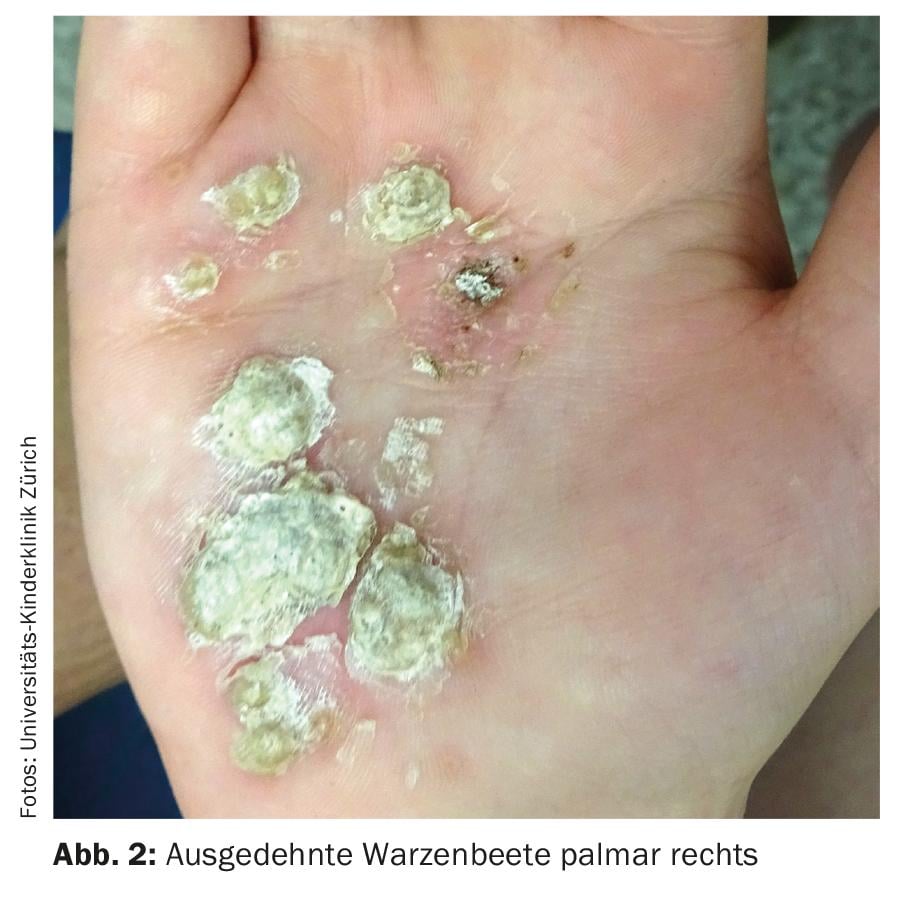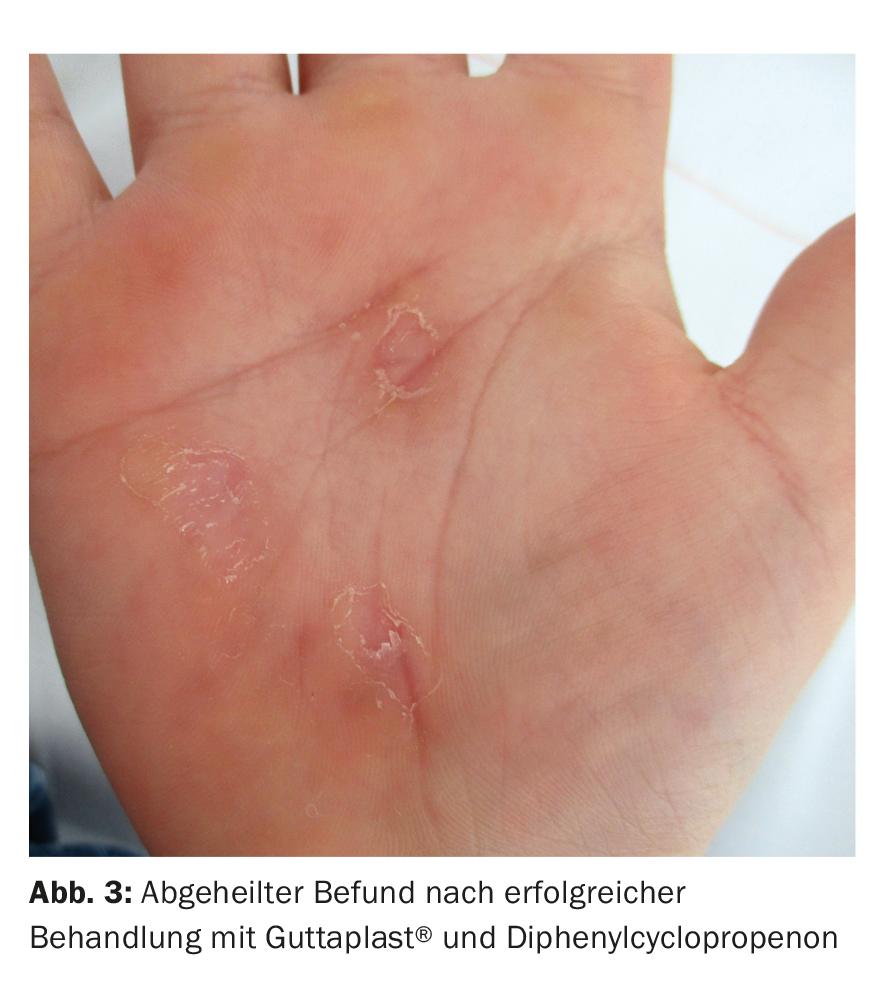Case report: A 6 11/12 year old girl presented to our consultation with marked verrucae vulgares on hands and feet. The warts had been present for >3 months and had not responded to commercial topicals. The girl was previously healthy except for recurrent small boils. There was no increase in other infections. Unremarkable family history except for warts in a maternal second cousin.
Clinical picture: palmar and plantar bds. a total of approx. 20 whitish, verrucous papules and plaques and additional extensive hyperkeratoses were seen (Figs. 1 and 2). On the right lower leg and on the right knee, a yellowish pustule measuring 0.5 cm on a reddish background was visible.
Quiz
What measure do you recommend?
A Keratolytic patches and repetitive mechanical removal of warts.
B Referral to immunology
C Oral zinc therapy and alternative practitioners
DCO2 laser therapy under anesthesia


Diagnosis and discussion: Besides the correct answer A with local keratolytic measures, the correct answer is also B: referral to immunology. In cases of extensive wart beds or large, conspicuously hyperkeratotic warts and recurrent soft tissue infections, a possible immunodeficiency should be considered and an extensive history of infection obtained.
In our patient, discrete neutropenia and anemia were conspicuous by laboratory chemistry. In addition, IgG was slightly decreased and lymphocyte typing revealed markedly decreased B and NK cells and decreased monocytes. Thus, there was a high suspicion of an underlying immunodeficiency (GATA2- defect or WHIM syndrome (wart hypogammaglobulinemia immunodeficiency myelokathexis syndrome)). Appropriate genetic diagnostics were initiated. The suspicion of a GATA2 defect was confirmed.
This is a primary immunodeficiency, which is characterized by monocytopenia, lymphocytopenia with NK and CD4 T-cell deficiency. Increased viral infections occur, especially cutaneous viral warts, which usually appear in adolescence and are often the first symptom of the disease. Transition to myelodysplastic syndrome or acute myeloid leukemia is possible [1]. Plantar verrucae vulgares are generally very common in childhood. However, in case of unusual clinical findings with conspicuously large and multiple warts and possibly anamnestic increased susceptibility to infections and/or immune dysregulation, a possible congenital immunodeficiency should be considered. Mutations in EVER1, EVER2, GATA2, CXCR4, and DOCK8 are typically associated with extensive HPV infections [1].
Treatment of palmoplantar warts is often protracted and particularly challenging in immunocompromised children. From our experience, the use of immunomodulatory therapy with diyphenylcyclopropenone (DCP) generally shows good chances of success in children with “difficult”/multiple warts. It is an obligate contact allergen which causes contact dermatitis after application. The advantage for children is mainly the simple and painless treatment only once a week. In addition, the therapy seems to respond particularly well in children. In a recent published study with a similar treatment plan as in our department, complete clinical remission of warts was seen in 83% of patients even one year after the end of treatment [2]. It is postulated that the induced immune response could develop specific immunity to HPV viruses and thus prevent HPV infection from recurring [3].
Our treatment scheme with DCP: First, the warts are removed by means of curettage after application of a patch containing salicyl (e.g. Guttaplast®). After a single sensitization of the patient with DCP Duofilm 0.5% on the warts themselves, a weekly application of DCP Duofilm 0.05% (occlusively under Opsite film, light protection by means of plaster/bandage) is made on the warts. If needed, curettage is also repeated weekly to improve the penetration of DCP on the wart. Treatment can be done at home with competent parents or with the help of caregivers. If there is no sufficient effect or inflammatory response after 4-6 weeks, a dose increase to DCP 0.1% or 0.5% can be attempted. DCP Duofilm is available at the Kantonsapotheke Zürich and is also made to order by other pharmacies.

In our patient, after only two months of therapy with Guttaplast, we observed® and DCP showed a very good response and after four months a complete healing of the warts without recurrence. (Fig. 3). Despite the overall good course regarding infections so far, the girl contracted a life-threatening varicella infection with varicella pneumonia and secondary macrophage activation syndrome a few months later, requiring hospitalization for several weeks.
Literature:
- Leiding JW, Holland SM, Warts, et al: Human papillomavirus in primary immunodeficiencies. J Allergy Clin Immunol. 2012 Nov; 130(5): 1030-48.
- Suh DW, Lew BL, Sim WY: Investigations of the Efficacy of Diphenylcyclopropenone Immunotherapy for the Treatment of Warts. Int J Dermatol. 2014 Dec; 53(12): e567-71.
- Choi MH, Seo SH, Kim IH, Son SW: Comparative study on the Sustained Efficacy of Diphencyprone Immunotherapy Versus Cryotherapy in Viral Warts. Pediatr Dermatol. 2008 May-Jun; 25(3): 398-9.
DERMATOLOGIE PRAXIS 2017; 27(1): 34-35











